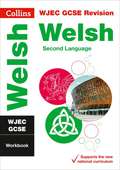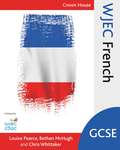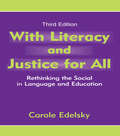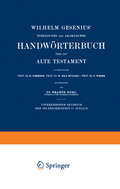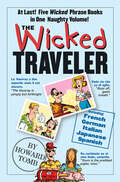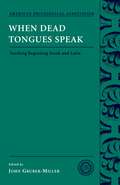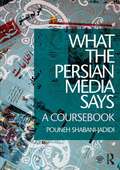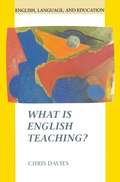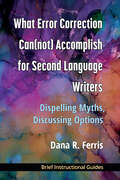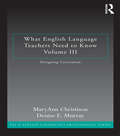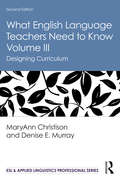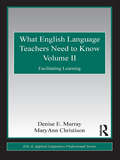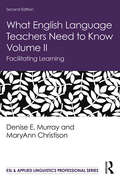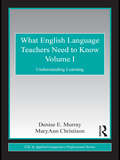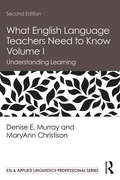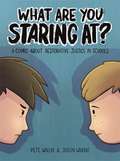- Table View
- List View
WJEC GCSE Welsh Second Language Workbook (Collins GCSE Revision (PDF))
by Collins GcseExam Board: WJEC Level: GCSE Subject: Welsh Second Language First Teaching: September 2017; First Exams: June 2019 This Collins WJEC Welsh Second Language GCSE Workbook contains topic-based questions as well as a full practice paper and answers. With lots of realistic practice opportunities for a variety of different exam-style questions. With a workbook and practice exam paper in one book, it contains plenty of practice opportunities to ensure the best results. Includes: • selection of questions covering each topic • topic-by-topic practice • complete exam-style paper
WJEC GCSE French (PDF)
by Bethan McHugh Chris Whittaker Louise PearceWe are delighted to announce that we are working closely with WJEC to ensure endorsement of a new series of textbooks for modern foreign languages. This textbook covers the reformed GCSEs for Wales, which will be taught from 2016 and awarded for the first time in 2018. This new textbook, covering the French GCSE qualification, has been designed in conjunction with examiners, specification developers and experienced teachers to support learners through the challenges of the new specifications. The textbook offers engaging and relevant content and provides comprehensive coverage of the WJEC themes and sub-themes, incorporating all of the new exam components, including: Literary and authentic texts Listening and reading tasks that correspond to the regulator s requirements (please note the required audio files are available with the relevant teacher guide) Role plays, photo cards and conversation questions Translation (from and into French) Increased focus on grammar including grammar in context sections Opportunities for stretch and challenge
With Literacy and Justice for All: Rethinking the Social in Language and Education
by Carole EdelskyThe third edition of With Literacy and Justice for All: Rethinking the Social in Language and Education continues to document Carole Edelsky's long involvement with socially critical, holistic approaches to the everyday problems and possibilities facing teachers of language and literacy. This book helps education professionals understand the educational/societal situations they are dealing with, and literacy instruction and second language learning in particular contexts. Edelsky does not offer simplistic pedagogical formulas, but rather, progressively works through differences and tensions in the discourses and practices of sociolinguistics, bilingual education, whole language, and critical pedagogy--fields whose practitioners and advocates too often work in isolation from each other and, at times, at cross purposes. In this edition, what Edelsky means by rethinking is improving and extending her own views, while at the same time demonstrating that such rethinking always occurs in the light of history. The volume includes a completely new Introduction and two entirely new chapters: one on reconceptualizing literacy learning as second language learning, and another on taking a historical view of responses to standardized testing. Throughout, in updating the volume, Edelsky uses a variety of structural styles to note contrasts in her views across time and to make the distinction clear between the original material and the current additions. This edition is a rare example of a scholarly owning-up to changes in thinking, and a much needed demonstration of the historically grounded nature of knowledge. As a whole, the third edition emphasizes recursiveness and questioning within a deliberately political framework.
With Literacy and Justice for All: Rethinking the Social in Language and Education
by Carole EdelskyThe third edition of With Literacy and Justice for All: Rethinking the Social in Language and Education continues to document Carole Edelsky's long involvement with socially critical, holistic approaches to the everyday problems and possibilities facing teachers of language and literacy. This book helps education professionals understand the educational/societal situations they are dealing with, and literacy instruction and second language learning in particular contexts. Edelsky does not offer simplistic pedagogical formulas, but rather, progressively works through differences and tensions in the discourses and practices of sociolinguistics, bilingual education, whole language, and critical pedagogy--fields whose practitioners and advocates too often work in isolation from each other and, at times, at cross purposes. In this edition, what Edelsky means by rethinking is improving and extending her own views, while at the same time demonstrating that such rethinking always occurs in the light of history. The volume includes a completely new Introduction and two entirely new chapters: one on reconceptualizing literacy learning as second language learning, and another on taking a historical view of responses to standardized testing. Throughout, in updating the volume, Edelsky uses a variety of structural styles to note contrasts in her views across time and to make the distinction clear between the original material and the current additions. This edition is a rare example of a scholarly owning-up to changes in thinking, and a much needed demonstration of the historically grounded nature of knowledge. As a whole, the third edition emphasizes recursiveness and questioning within a deliberately political framework.
Wilhelm Gesenius’ Hebräisches und Aramäisches Handwörterbuch über das Alte Testament
by Frants BuhlDieser Buchtitel ist Teil des Digitalisierungsprojekts Springer Book Archives mit Publikationen, die seit den Anfängen des Verlags von 1842 erschienen sind. Der Verlag stellt mit diesem Archiv Quellen für die historische wie auch die disziplingeschichtliche Forschung zur Verfügung, die jeweils im historischen Kontext betrachtet werden müssen. Dieser Titel erschien in der Zeit vor 1945 und wird daher in seiner zeittypischen politisch-ideologischen Ausrichtung vom Verlag nicht beworben.
The Wicked Traveler
by Howard TombRespond to Japanese Noh theater like a native: Kazoku sorrote no seppuku ga yokatta. (“I love the part where the whole family disembowels themselves.”) Speak to homicidal Parisian taxi drivers in a language they’ll understand: Ou avez-vous appris à conduire? En Italie? (“Where did you learn to drive? Italy?”) Discuss Italian olive oil with the proper degree of reverence: Un assaggio ti dice che le olive sono maturate di fronte ad una cattedrale. (“One taste tells you the olives grew in full view of the cathedral.”) Establish privacy needs in Mexico: Preferiría una habitación sin alacranes. (“I’d prefer a room without scorpions.”) With seven titles and over 1.2 million copies in print, Howard Tomb’s Wicked phrase book series is the fiendishly irreverent—and very successful—collection that gives travelers the words they wish they could utter while, say, attempting to find the exit of the Louvre or facing a plate of fugu (poisonous blowfish) in Japan. Now, the five most popular Wicked books—Italian, French, Japanese, German, and Spanish— have been updated and compiled into The Wicked Traveler. A$25 value for $8.95, it’s the ultimate impulse gift for anyone who’d like to know how to say silly things in five different languages. Because, as Howard Tomb writes in his new introduction: “Every country is different, but all foreign places have one thing in common: they’re weird.”
When Dead Tongues Speak: Teaching Beginning Greek and Latin (Society for Classical Studies Classical Resources)
by John Gruber-MillerWhen Dead Tongues Speak introduces classicists to the research that linguists, psychologists, and language teachers have conducted over the past thirty years and passes along their most important insights. The essays cover a broad range of topics, including cognitive styles, peer teaching and collaboration, learning disabilities, feminist pedagogy, speaking, and writing. Each contributor addresses a different problem in the learning process based on his or her own teaching experience, and each chapter combines a theoretical overview with practical examples of classroom activities. The book was developed for classroom use in Greek and Latin methodology classes in M.A. and M.A.T. programs. It will also appeal to Latin and Greek language instructors who want to get current with the latest scholarship and pedagogical models.
When Dead Tongues Speak: Teaching Beginning Greek and Latin (Society for Classical Studies Classical Resources)
by John Gruber-MillerWhen Dead Tongues Speak introduces classicists to the research that linguists, psychologists, and language teachers have conducted over the past thirty years and passes along their most important insights. The essays cover a broad range of topics, including cognitive styles, peer teaching and collaboration, learning disabilities, feminist pedagogy, speaking, and writing. Each contributor addresses a different problem in the learning process based on his or her own teaching experience, and each chapter combines a theoretical overview with practical examples of classroom activities. The book was developed for classroom use in Greek and Latin methodology classes in M.A. and M.A.T. programs. It will also appeal to Latin and Greek language instructors who want to get current with the latest scholarship and pedagogical models.
What the Persian Media says: A Coursebook
by Pouneh Shabani-JadidiWhat the Persian Media Says: A Coursebook is a comprehensive and stimulating course for intermediate to advanced students of Persian. Presenting many exercises based on authentic Persian newspaper texts, the course thoroughly introduces students to the language of the news in Iran. Real cultural content is featured throughout and there is a strong focus on enabling students to gain familiarity with day-to-day modern Persian discourse. Features include: A wide range of interesting and challenging exercises presented throughout, including activities designed to both test students’ knowledge in a classroom setting and to search online for further Persian news resources Usage of authentic texts from the Iranian media, written for native speakers, with sources including Ettel?’?t, Keyh?n, Sharq, E’tem?d, Ir?n, and Mardoms?l?ri Coverage of topics highly relevant to modern day Persian society, including the Arts, divorce, violence, problems of youth, unemployment, politics and economic issues, enabling cultural engagement and knowledge of complex expressions and idioms used in the media A comprehensive bilingual glossary of journalistic and non-journalistic terminology used in the newspaper texts, provided at the back of the book for easy access All the newspaper texts and their corresponding audio files available for free download at http://routledgetextbooks.com/textbooks/9781138825567/ What the Persian Media Says combines modern and more traditional techniques of language teaching. With all the newspaper texts and their corresponding audio files available for free on the Routledge website, students can read the texts in digital form and listen to the audio while working on exercises in the book, enabling full and exciting engagement with the course materials. Written by an experienced instructor, this will be an invaluable resource for intermediate to advanced undergraduate and postgraduate students of Persian. It can also be used by self-learners and by instructors and students on intensive courses and summer language programs.
What the Persian Media says: A Coursebook
by Pouneh Shabani-JadidiWhat the Persian Media Says: A Coursebook is a comprehensive and stimulating course for intermediate to advanced students of Persian. Presenting many exercises based on authentic Persian newspaper texts, the course thoroughly introduces students to the language of the news in Iran. Real cultural content is featured throughout and there is a strong focus on enabling students to gain familiarity with day-to-day modern Persian discourse. Features include: A wide range of interesting and challenging exercises presented throughout, including activities designed to both test students’ knowledge in a classroom setting and to search online for further Persian news resources Usage of authentic texts from the Iranian media, written for native speakers, with sources including Ettel?’?t, Keyh?n, Sharq, E’tem?d, Ir?n, and Mardoms?l?ri Coverage of topics highly relevant to modern day Persian society, including the Arts, divorce, violence, problems of youth, unemployment, politics and economic issues, enabling cultural engagement and knowledge of complex expressions and idioms used in the media A comprehensive bilingual glossary of journalistic and non-journalistic terminology used in the newspaper texts, provided at the back of the book for easy access All the newspaper texts and their corresponding audio files available for free download at http://routledgetextbooks.com/textbooks/9781138825567/ What the Persian Media Says combines modern and more traditional techniques of language teaching. With all the newspaper texts and their corresponding audio files available for free on the Routledge website, students can read the texts in digital form and listen to the audio while working on exercises in the book, enabling full and exciting engagement with the course materials. Written by an experienced instructor, this will be an invaluable resource for intermediate to advanced undergraduate and postgraduate students of Persian. It can also be used by self-learners and by instructors and students on intensive courses and summer language programs.
What Is English Teaching? (UK Higher Education OUP Humanities & Social Sciences Education OUP)
by Chris DavisIs it the role of English teachers to teach basic literacy skills?If not, what do English teachers think they should be doing? How should basic literacy be taught in schools?These are important questions which have recently attracted significant political, media and parental debate. In addressing them, this book explores the question What is English Teaching? from a variety of perspectives, including teachers' beliefs about what they should be teaching, the views of the government, and the reality of young people's experiences in the 1990s. In particular, it explores the question of how - and even whether - the English subject area is capable of meeting its own, and the outside world's, expectations for teaching not only its specialist concerns, but also general literacy. The book explores ways in which the teaching of English might develop - for instance, by balancing its efforts evenly between literature study, media study and knowledge about language - and how it might contribute to wider literacy teaching, by sharing its distinctive teaching strategies with teachers of other subjects.
What Error Correction Can(not) Accomplish for Second Language Writers: DIspelling Myths, Discussing Options
by Dana R. FerrisThis book looks at aspects of L2 research that influence error correction, finding that second language acquisition takes time and that second language writers' texts differ from those written by native English speakers. Using this research, Dana R. Ferris dispels the myth that diligent teacher correction and student editing can lead to perfect, error-free texts. In clear and simple terms, Ferris makes six suggestions for things teachers can do in the classroom regarding error correction and provides samples. Other issues regarding the expectations of students and others—such as in timed (high-stakes) situations—as it relates to "perfect" papers are examined. The book closes by addressing the basic principles of developing students' language skills in second language/ESL writing classes.
What English Language Teachers Need to Know Volume III: Designing Curriculum
by MaryAnn Christison Denise E. MurrayWhat English Teachers Need to Know, a set of companion texts designed for pre-service teachers and teachers new to the field of ELT, addresses the key question: What do English language teachers need to know and be able to do in order for their students to learn English? These texts work for teachers across different contexts (countries where English is the dominant language, one of the official languages, or taught as a foreign language); different levels (elementary/primary, secondary, college or university, or adult education); and different learning purposes (general English, workplace English, English for academic purposes, or English for specific purposes). Volume I, on understanding learning, provides the background information that teachers need to know and be able to use in their classroom. Volume II, on facilitating learning, covers the three main facets of teaching: planning, instructing, and assessing. Volume III, on designing curriculum, covers the contexts for, processes in, and types of ELT curricula—linguistic based, content-based, learner-centered, and learning-centered. Throughout the three volumes, the focus is on outcomes, that is, student learning. Features • Situated in current research in the field of English language teaching and other disciplines that inform it • Sample data, including classroom vignettes • Three kinds of activities/tasks: Reflect, Explore, and Expand
What English Language Teachers Need to Know Volume III: Designing Curriculum
by MaryAnn Christison Denise E. MurrayWhat English Teachers Need to Know, a set of companion texts designed for pre-service teachers and teachers new to the field of ELT, addresses the key question: What do English language teachers need to know and be able to do in order for their students to learn English? These texts work for teachers across different contexts (countries where English is the dominant language, one of the official languages, or taught as a foreign language); different levels (elementary/primary, secondary, college or university, or adult education); and different learning purposes (general English, workplace English, English for academic purposes, or English for specific purposes). Volume I, on understanding learning, provides the background information that teachers need to know and be able to use in their classroom. Volume II, on facilitating learning, covers the three main facets of teaching: planning, instructing, and assessing. Volume III, on designing curriculum, covers the contexts for, processes in, and types of ELT curricula—linguistic based, content-based, learner-centered, and learning-centered. Throughout the three volumes, the focus is on outcomes, that is, student learning. Features • Situated in current research in the field of English language teaching and other disciplines that inform it • Sample data, including classroom vignettes • Three kinds of activities/tasks: Reflect, Explore, and Expand
What English Language Teachers Need to Know Volume III: Designing Curriculum (ESL & Applied Linguistics Professional Series)
by MaryAnn Christison Denise E. MurrayDesigned for pre-service and novice teachers in ELT, What English Language Teachers Need to Know Volumes I, II, and III are companion textbooks organized around the key question: What do teachers need to know and be able to do in order to help their students to learn English?Thoroughly revised and updated, the second edition of Volume III explores the contexts for ELT curricula; explains key processes in curriculum design; and sets out approaches to curricula that are linguistic-based, content-based, learner centered, and learning centered. Organized around the three pillars of teaching—planning, instructing, and assessing—chapters in the second edition are updated to include current research and theory to meet the needs of today’s teachers, and feature new or revised vignettes and activities. New chapters help teachers understand both the technological and multilingual approaches that learners need to succeed today. The comprehensive texts of this series are suitable resources for teachers across different contexts—where English is the dominant language, an official language, or a foreign language; for different levels—elementary/primary, secondary, university, or adult education; and for different learning purposes—general English, workplace English, English for academic purposes, or English for specific purposes.
What English Language Teachers Need to Know Volume III: Designing Curriculum (ESL & Applied Linguistics Professional Series)
by MaryAnn Christison Denise E. MurrayDesigned for pre-service and novice teachers in ELT, What English Language Teachers Need to Know Volumes I, II, and III are companion textbooks organized around the key question: What do teachers need to know and be able to do in order to help their students to learn English?Thoroughly revised and updated, the second edition of Volume III explores the contexts for ELT curricula; explains key processes in curriculum design; and sets out approaches to curricula that are linguistic-based, content-based, learner centered, and learning centered. Organized around the three pillars of teaching—planning, instructing, and assessing—chapters in the second edition are updated to include current research and theory to meet the needs of today’s teachers, and feature new or revised vignettes and activities. New chapters help teachers understand both the technological and multilingual approaches that learners need to succeed today. The comprehensive texts of this series are suitable resources for teachers across different contexts—where English is the dominant language, an official language, or a foreign language; for different levels—elementary/primary, secondary, university, or adult education; and for different learning purposes—general English, workplace English, English for academic purposes, or English for specific purposes.
What English Language Teachers Need to Know Volume II: Facilitating Learning
by Denise E. Murray MaryAnn ChristisonDesigned for pre-service teachers and teachers new to the field of ELT, Volume II and its companion are companion textbook, Volume I, are volumes organized around the key question: What do teachers need to know and be able to do in order for their students to learn English? Volume I covers the characteristics of the context in which teachers work, how English works and how it is learned, and the teacher’s role in the larger professional sphere of English language education. Volume II covers the three main facets of teaching: planning, instructing, and assessing. The focus throughout is on outcomes, that is, student learning. The texts work for teachers across different contexts (countries where English is the dominant language, one of the official languages, or taught as a foreign language); different levels (elementary/primary, secondary, college or university, or adult education), and different learning purposes (general English, workplace English, English for academic purposes, or English for specific purposes).
What English Language Teachers Need to Know Volume II: Facilitating Learning
by Denise E. Murray MaryAnn ChristisonDesigned for pre-service teachers and teachers new to the field of ELT, Volume II and its companion are companion textbook, Volume I, are volumes organized around the key question: What do teachers need to know and be able to do in order for their students to learn English? Volume I covers the characteristics of the context in which teachers work, how English works and how it is learned, and the teacher’s role in the larger professional sphere of English language education. Volume II covers the three main facets of teaching: planning, instructing, and assessing. The focus throughout is on outcomes, that is, student learning. The texts work for teachers across different contexts (countries where English is the dominant language, one of the official languages, or taught as a foreign language); different levels (elementary/primary, secondary, college or university, or adult education), and different learning purposes (general English, workplace English, English for academic purposes, or English for specific purposes).
What English Language Teachers Need to Know Volume II: Facilitating Learning (ESL & Applied Linguistics Professional Series)
by Denise E. Murray MaryAnn ChristisonDesigned for pre-service teachers and teachers new to the field of ELT, Volume II of the What English Language Teachers Need to Know set covers the three main facets of teaching: planning, instructing, and assessing. Updated with new research throughout, the focus throughout is on outcomes, that is, student learning. The texts work for teachers across different contexts; different levels, and different learning purposes. The Second Edition has expanded to address corpus-based data, new technologies, and a wider range of contexts.
What English Language Teachers Need to Know Volume II: Facilitating Learning (ESL & Applied Linguistics Professional Series)
by Denise E. Murray MaryAnn ChristisonDesigned for pre-service teachers and teachers new to the field of ELT, Volume II of the What English Language Teachers Need to Know set covers the three main facets of teaching: planning, instructing, and assessing. Updated with new research throughout, the focus throughout is on outcomes, that is, student learning. The texts work for teachers across different contexts; different levels, and different learning purposes. The Second Edition has expanded to address corpus-based data, new technologies, and a wider range of contexts.
What English Language Teachers Need to Know Volume I: Understanding Learning
by Denise E. Murray MaryAnn ChristisonDesigned for pre-service teachers and teachers new to the field of ELT, What English Teachers Need to Know I and II are companion textbooks organized around the key question: What do teachers need to know and be able to do in order for their students to learn English? The focus throughout is on outcomes, that is, student learning. Volume I, on understanding learning, provides the background information that teachers need to know and be able to use in their classroom: the characteristics of the context in which they work how English works and how it is learned their role in the larger professional sphere of English language education Volume II, on facilitating learning, covers the three main facets of teaching: planning instructing assessing The texts work for teachers across different contexts (countries where English is the dominant language, one of the official languages, or taught as a foreign language); different levels (elementary/primary, secondary, college or university, or adult education), and different learning purposes (general English, workplace English, English for academic purposes, or English for specific purposes).
What English Language Teachers Need to Know Volume I: Understanding Learning
by Denise E. Murray MaryAnn ChristisonDesigned for pre-service teachers and teachers new to the field of ELT, What English Teachers Need to Know I and II are companion textbooks organized around the key question: What do teachers need to know and be able to do in order for their students to learn English? The focus throughout is on outcomes, that is, student learning. Volume I, on understanding learning, provides the background information that teachers need to know and be able to use in their classroom: the characteristics of the context in which they work how English works and how it is learned their role in the larger professional sphere of English language education Volume II, on facilitating learning, covers the three main facets of teaching: planning instructing assessing The texts work for teachers across different contexts (countries where English is the dominant language, one of the official languages, or taught as a foreign language); different levels (elementary/primary, secondary, college or university, or adult education), and different learning purposes (general English, workplace English, English for academic purposes, or English for specific purposes).
What English Language Teachers Need to Know Volume I: Understanding Learning (ESL & Applied Linguistics Professional Series)
by Denise E. Murray MaryAnn ChristisonDesigned for pre-service teachers and teachers new to the field of ELT, What English Teachers Need to Know Volumes I, II, and III are companion textbooks organized around the key question: What do teachers need to know and be able to do in order for their students to learn English? In the Second Edition of Volume I, Murray and Christison return to this essential question and call attention to emerging trends and challenges affecting the contemporary classroom. Addressing new skills and strategies that EFL teachers require to meet the needs of their shifting student populations who are impacted by changing demographics, digital environments, and globalization, this book, which is grounded in current research, offers a strong emphasis on practical applications for classroom teaching. This updated and expanded Second Edition features: a new chapter on technology in TESOL new and updated classroom examples throughout discussions of how teachers can prepare for contemporary challenges, such as population mobility and globalization The comprehensive texts work for teachers across different contexts—where English is the dominant language, an official language, or a foreign language; for different levels—elementary/primary, secondary, university, or adult education; and for different learning purposes—general English, workplace English, English for academic purposes, or English for specific purposes.
What English Language Teachers Need to Know Volume I: Understanding Learning (ESL & Applied Linguistics Professional Series)
by Denise E. Murray MaryAnn ChristisonDesigned for pre-service teachers and teachers new to the field of ELT, What English Teachers Need to Know Volumes I, II, and III are companion textbooks organized around the key question: What do teachers need to know and be able to do in order for their students to learn English? In the Second Edition of Volume I, Murray and Christison return to this essential question and call attention to emerging trends and challenges affecting the contemporary classroom. Addressing new skills and strategies that EFL teachers require to meet the needs of their shifting student populations who are impacted by changing demographics, digital environments, and globalization, this book, which is grounded in current research, offers a strong emphasis on practical applications for classroom teaching. This updated and expanded Second Edition features: a new chapter on technology in TESOL new and updated classroom examples throughout discussions of how teachers can prepare for contemporary challenges, such as population mobility and globalization The comprehensive texts work for teachers across different contexts—where English is the dominant language, an official language, or a foreign language; for different levels—elementary/primary, secondary, university, or adult education; and for different learning purposes—general English, workplace English, English for academic purposes, or English for specific purposes.
What are you staring at?: A Comic About Restorative Justice in Schools (PDF)
by Joseph Wilkins Pete WallisDesigned for use in schools, this comic teaches children about restorative justice through the story of Jake and Ryan. After a misunderstanding between Jake and Ryan leads to a fight in the playground, both boys are left feeling angry and fearful about what might happen when they see each other again. Rather than keeping Jake and Ryan apart, their teacher arranges a restorative meeting to allow the boys to understand the situation from the other's perspective and transform their negative emotions into positive ones. This comic is a key resource in helping children aged 8-13 to understand restorative justice and prepare for a restorative meeting. The comic also features a resource section for teachers, explaining more about restorative practices and how they can be used in schools to foster respect and emotional literacy among students.
